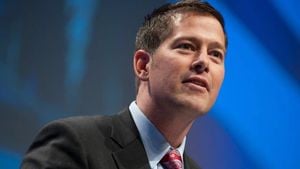General Motors (GM) has made headlines recently with its announcement of laying off about 1,000 employees, marking another chapter in the automaker's tumultuous transition toward electric vehicles (EVs). The layoffs, which reportedly affected both hourly and salaried workers, were disclosed on November 15, 2024, and have sparked significant controversy, particularly among workers and the United Auto Workers (UAW) union.
The heart of the matter lies not just with the layoffs themselves, but with the timing and the manner of the notifications. Many workers received their termination notices early Friday morning through impersonal emails—a move criticized for its lack of compassion. "It should never be delivered like this," remarked one affected employee, expressing dismay at how the company treated long-standing workers.
Efficiency Claims Amid Record Profits
GM’s leadership has defended the layoffs as necessary to increase efficiency, claiming the need to operate with greater speed and maintain its competitive edge. The automaker stated, "To win in this competitive market, we need to optimize for speed and excellence," emphasizing the need for the right team structure and operational focus. This rationale, delivered by the company's spokespeople, feels particularly disheartening to those laid off, especially since GM reported significant profits during this time.
Among those affected were around 50 hourly workers represented by the UAW, which prompted sharp responses from union officials. UAW Vice President Mike Booth passionately condemned the cuts, pointing out the contradiction of cutting jobs amid record profits. "GM is trying to cut around 50 UAW jobs when they’re making record profits," he stated. Union leaders are bracing for protracted negotiations, especially during this contentious period for labor relations within the automotive industry.
Recent Facility Closures and Outsourcing Strategies
The layoffs align with GM's broader corporate strategy, which includes shutting down key operations at its Yuma, Arizona proving grounds—essential for testing vehicles under extreme heat conditions. The company is also closing Durability, Corrosion, and Teardown facilities at its Milford Proving Grounds. Rather than managing these tests internally, GM plans to outsource them to suppliers, aiming to reduce operational costs. This shift mirrors what GM's rival, Stellantis, recently announced concerning their own testing capabilities.
The EV Market: Challenges Ahead
GM’s transition to EVs remains fraught with challenges, particularly as demand for electric vehicles has started to slow down. Despite significant investments, the company's EV production goals have had to be adjusted. For 2024, GM has cut its projected EV production targets by 50,000 units, with rising material costs and shifting consumer preferences compounding difficulties.
Analysts are quick to note the market dynamics; Tesla continues to dominate the EV space with nearly 50% of U.S. sales, leaving GM trailing at about 9%. This discrepancy is more than just numbers; it reflects the broader competitive pressures GM faces as it navigates between gas-powered and electric models lifeboats.
Broader Implications for the Company’s Workforce
The recent job cuts have left many loyal employees feeling uncertain about their future. Several laid-off workers expressed frustration, especially those who had devoted years to the company. One veteran employee with over two decades at GM lamented the loss of jobs held by those with excellent performance records, stating, "It’s disheartening to see how the company values us after so many years."
This sentiment resonates at various team levels, with remaining employees feeling the pressure of increased workloads and decreased morale. The legacy of GM’s layoffs doesn’t just impact those leaving; it permeates the culture and trust within the organization, making it challenging to sustain motivation among remaining staff.
Looking Forward: A Difficult Road Ahead
Although GM maintains it needs to cut costs to remain competitive, the decision has sparked backlash within its workforce and surrounding communities. Critics argue these layoffs could undermine long-term innovation and quality, as cutting ties with experienced professionals may not yield the desired results. The recent layoffs cast shadows over GM’s future; the company must balance immediate cost-saving measures with the need for sustained employee engagement and development.
For now, as GM continues to adjust to the changing automotive market—marked by special challenges within the EV segment—it may find it difficult to rebuild trust with its workforce.
GM’s case exemplifies the complex, often contentious relationship between modernization, workforce stability, and the pursuit of profitability. The fallout from these layoffs could shape corporate attitudes toward labor relations and responsibility for years to come, challenging the company to prove its commitment not only to its bottom line but to its loyal workforce. Time will tell how this storied automaker will reconcile the tension between technological progress and human capital.



